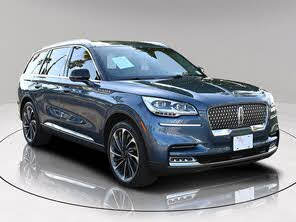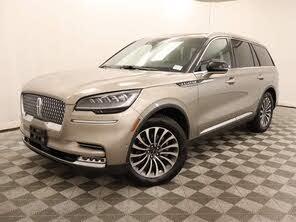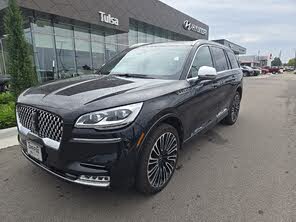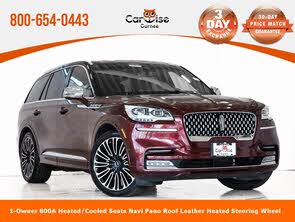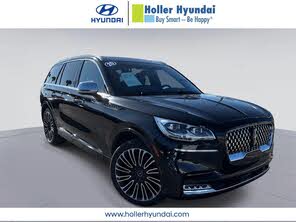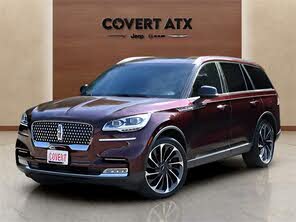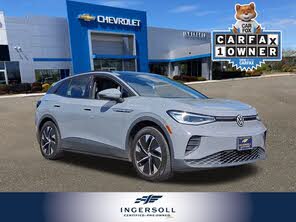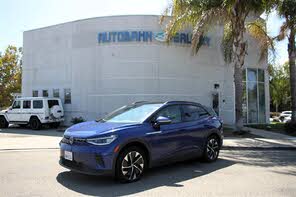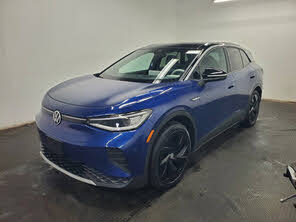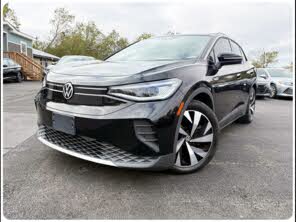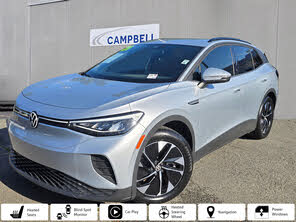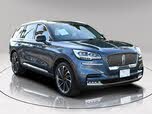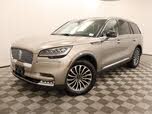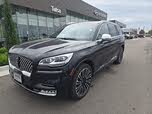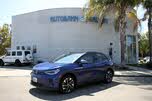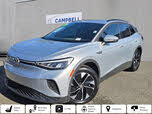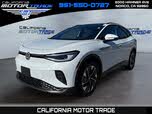2020 Lincoln Aviator vs 2021 Volkswagen ID.4
Overview | |
MSRP$51,100 | MSRP$39,995 |
Listings591 | Listings396 |
Ratings & Reviews | |
User Reviews | User Reviews |
Expert reviews8.2 out of 10 | Expert reviews7.3 out of 10 |
Pros
Cons
| Pros
Cons
|
2020 Lincoln Aviator Reviews SummaryThe heyday for Lincoln was more than a half-century ago. Those postwar years of prosperity and optimism were the perfect time for cars like the Continental and others. They delivered comfort and luxury, wrapped in midcentury modern styling. Even as recently as the 1990s, Lincoln was still a popular brand, riding the SUV craze with its Navigator. But after the turn of the century, Lincoln lost its ability to create new designs and looked inward and backward. Sure, retro-themed cars like the redesigned Mustang, PT Cruiser, and Chevy HHR had turned some heads, but none of those came from luxury brands. The BMWs and Mercedes of the world were all looking forward and pushing the envelope for contemporary automotive design. Meanwhile, Lincoln offered the MKX, which was based on the Ford Edge and featured ’66 Continental styling. Neat in a vacuum, but off-base compared to the modern luxury market. This experimental phase with various retro looks coincided with the move to the MK-# alphabet-soup naming convention and big improvements in the Ford lineup, where top-end trims of the Fusion overlapped with an entry-level trim of the MKZ. The combination left Lincoln a confusing, anonymous afterthought in the modern luxury game. But Lincoln is finally ready to change all that. It has a new cohesive design language, its focus is once again on luxury, and the three-letter naming convention that never meant anything to anyone other than Lincoln marketers is gone. The brand led with the 2017 Continental and 2018 Navigator, which are each impressive in their own right. But the company's lineup is growing and now includes the all-new 2020 Lincoln Aviator. Named after a luxury variant of the 2002-2005 Ford Explorer, this new Aviator is also based on the contemporary Explorer platform, but it's a luxury vehicle in its own right. Much of the success of the Lincoln brand may hinge on this midsize, 3-row luxury SUV, so you need to consider its competition, such as the Audi Q7, Infiniti QX60, and all-new Cadillac XT6. Read on to learn if Lincoln’s take on luxury will stand out in a crowded competitive field. | |
2021 Volkswagen ID.4 Reviews SummaryThe “Dieselgate” emissions scandal forced Volkswagen to double down on electric cars, and now we’re finally seeing the first result of that: the 2021 Volkswagen ID.4 electric crossover. VW has made an electric car before, but its last attempt, the e-Golf, was built to satisfy emissions standards, not rack up sales. It was barely advertised, and it was sold only in certain states. That’s not the case with the ID.4, which will be available nationwide and will even be built in Tennessee starting in 2022. Volkswagen views the ID.4 as a rival not to other EVs, but to mainstream gasoline vehicles like the Honda CR-V and Toyota RAV4. Being late to the party means there are already several other EVs trying to coax new-car buyers away from internal combustion, however. If you want a reasonably-priced EV, the Nissan Leaf, Hyundai Kona Electric, and Kia Niro EV already exist, and General Motors just announced the 2022 Chevrolet Bolt EUV—a new variant of the Chevy Bolt EV with a crossover body style similar to the Volkswagen. We tested an ID.4 1st Edition, which commemorates the car’s launch, and an ID.4 PRO S with all-wheel drive (AWD). The 1st Edition is a limited-edition model that has already sold out, but it’s mechanically identical to the ID.4 Pro S AWD, albeit with power sent only to the rear wheels. | |
Popular Features & Specs | |
Engine3.0L 400 hp V6 | Engine201 hp Electric |
Drive TrainRWD | Drive TrainRWD |
Seating Capacity7 | Seating Capacity5 |
EV Battery Capacity | EV Battery Capacity82 kWh |
MPG City18 | MPG City104 |
MPG Highway26 | MPG Highway89 |
Battery Charge Time (240V) | Battery Charge Time (240V)8 hours |
Engine | |
Engine Name3.0L 400 hp V6 | Engine Name201 hp Electric |
Battery Charge Time (240V) | Battery Charge Time (240V)8 hours |
DrivetrainRWD | DrivetrainRWD |
Fuel Economy | |
EV Battery Capacity | EV Battery Capacity82 kWh |
MPG City18 | MPG City104 |
MPG Highway26 | MPG Highway89 |
Interior | |
Seating Capacity7 | Seating Capacity5 |
Safety | |
Front Crash Overall5 | Front Crash Overall5 |
Side Crash Overall5 | Side Crash Overall5 |
Dimensions & Capacity | |
Cargo Space18.3 cu ft | Cargo Space30.3 cu ft |
Curb Weight4764 lbs | Curb Weight4517 lbs |
Height69.8 in | Height64.4 in |
Length199.3 in | Length180.5 in |
Width89.9 in | Width72.9 in |
Wheelbase119.1 in | Wheelbase108.9 in |
Maximum Payload | Maximum Payload1347 lbs |
Number of doors4 | Number of doors4 |
Overview | ||
MSRP | $51,100 | $39,995 |
Listings | ||
Ratings & Reviews | ||
User reviews | ||
Expert reviews | 8.2 out of 10Read full review | 7.3 out of 10Read full review |
Pros & cons | Pros
Cons
| Pros
Cons
|
Summary | The heyday for Lincoln was more than a half-century ago. Those postwar years of prosperity and optimism were the perfect time for cars like the Continental and others. They delivered comfort and luxury, wrapped in midcentury modern styling. Even as recently as the 1990s, Lincoln was still a popular brand, riding the SUV craze with its Navigator. But after the turn of the century, Lincoln lost its ability to create new designs and looked inward and backward. Sure, retro-themed cars like the redesigned Mustang, PT Cruiser, and Chevy HHR had turned some heads, but none of those came from luxury brands. The BMWs and Mercedes of the world were all looking forward and pushing the envelope for contemporary automotive design. Meanwhile, Lincoln offered the MKX, which was based on the Ford Edge and featured ’66 Continental styling. Neat in a vacuum, but off-base compared to the modern luxury market. This experimental phase with various retro looks coincided with the move to the MK-# alphabet-soup naming convention and big improvements in the Ford lineup, where top-end trims of the Fusion overlapped with an entry-level trim of the MKZ. The combination left Lincoln a confusing, anonymous afterthought in the modern luxury game. But Lincoln is finally ready to change all that. It has a new cohesive design language, its focus is once again on luxury, and the three-letter naming convention that never meant anything to anyone other than Lincoln marketers is gone. The brand led with the 2017 Continental and 2018 Navigator, which are each impressive in their own right. But the company's lineup is growing and now includes the all-new 2020 Lincoln Aviator. Named after a luxury variant of the 2002-2005 Ford Explorer, this new Aviator is also based on the contemporary Explorer platform, but it's a luxury vehicle in its own right. Much of the success of the Lincoln brand may hinge on this midsize, 3-row luxury SUV, so you need to consider its competition, such as the Audi Q7, Infiniti QX60, and all-new Cadillac XT6. Read on to learn if Lincoln’s take on luxury will stand out in a crowded competitive field. | The “Dieselgate” emissions scandal forced Volkswagen to double down on electric cars, and now we’re finally seeing the first result of that: the 2021 Volkswagen ID.4 electric crossover. VW has made an electric car before, but its last attempt, the e-Golf, was built to satisfy emissions standards, not rack up sales. It was barely advertised, and it was sold only in certain states. That’s not the case with the ID.4, which will be available nationwide and will even be built in Tennessee starting in 2022. Volkswagen views the ID.4 as a rival not to other EVs, but to mainstream gasoline vehicles like the Honda CR-V and Toyota RAV4. Being late to the party means there are already several other EVs trying to coax new-car buyers away from internal combustion, however. If you want a reasonably-priced EV, the Nissan Leaf, Hyundai Kona Electric, and Kia Niro EV already exist, and General Motors just announced the 2022 Chevrolet Bolt EUV—a new variant of the Chevy Bolt EV with a crossover body style similar to the Volkswagen. We tested an ID.4 1st Edition, which commemorates the car’s launch, and an ID.4 PRO S with all-wheel drive (AWD). The 1st Edition is a limited-edition model that has already sold out, but it’s mechanically identical to the ID.4 Pro S AWD, albeit with power sent only to the rear wheels. |
Video | ||
Popular Features & Specs | ||
Engine | 3.0L 400 hp V6 | 201 hp Electric |
Drive Train | RWD | RWD |
Seating Capacity | 7 | 5 |
EV Battery Capacity | 82 kWh | |
MPG City | 18 | 104 |
MPG Highway | 26 | 89 |
Battery Charge Time (240V) | 8 hours | |
Engine | ||
Engine Name | 3.0L 400 hp V6 | 201 hp Electric |
Battery Charge Time (240V) | 8 hours | |
Drivetrain | RWD | RWD |
Fuel Economy | ||
EV Battery Capacity | 82 kWh | |
MPG City | 18 | 104 |
MPG Highway | 26 | 89 |
Interior | ||
Seating Capacity | 7 | 5 |
Safety | ||
Front Crash Overall | 5 | 5 |
Side Crash Overall | 5 | 5 |
Dimensions & Capacity | ||
Cargo Space | 18.3 cu ft | 30.3 cu ft |
Curb Weight | 4764 lbs | 4517 lbs |
Height | 69.8 in | 64.4 in |
Length | 199.3 in | 180.5 in |
Width | 89.9 in | 72.9 in |
Wheelbase | 119.1 in | 108.9 in |
Maximum Payload | 1347 lbs | |
Number of doors | 4 | 4 |
The 2020 Lincoln Aviator was positioned between the larger Navigator and the smaller MKC, which was later replaced by the Corsair. Lincoln's return to using real vehicle names instead of alphanumeric codes was a positive shift, signaling a move away from mimicking import brands. The Aviator featured a cohesive design language across Lincoln's lineup, with elegant headlights and a prominent chrome grille. Its roofline tapered slightly, giving it an elongated appearance, while the low, wide beltline contributed to a boat-like aesthetic. Inside, the Aviator's cabin boasted a flowing design with soft-touch materials and selective brightwork. The seats were both elegant and sturdy, with shifter buttons resembling piano keys. Lincoln aimed to evoke a sense of Golden Age luxury without overcommitting to a retro design language, a misstep seen in the brand's previous decade. The front seats were notably comfortable, with plush leather extending to areas not typically upholstered, underscoring Lincoln's commitment to luxury. Unique touches like a panoramic moonroof and orchestral warning jingles recorded by the Detroit Symphony Orchestra highlighted Lincoln's holistic approach to luxury.
The 2021 Volkswagen ID.4 was designed as an electric vehicle from the ground up, showcasing a distinctive look that set it apart from Volkswagen's gasoline models. Unlike the Tiguan and Atlas, the ID.4 featured a streamlined profile with wheels pushed to the corners, eschewing the rugged styling of its gasoline counterparts. Built on VW's MEB platform, the ID.4 followed the European-market ID.3 hatchback, with Volkswagen opting to introduce the crossover to the U.S. market due to its popularity. While the ID.4 shared some design elements with the ID.3, it didn't quite resemble a traditional SUV, a common trait among many EV crossovers. The interior combined Volkswagen's minimalist design with a tech-focused aesthetic, featuring piano black and matte plastic elements. The base ID.4 Pro came with a leather-wrapped steering wheel and cloth seats, while the Pro S and 1st Edition models offered leatherette upholstery. Despite its unique design, the ID.4's interior was spacious, with good forward visibility, although rearward visibility was hindered by thick rear pillars and a small back window.











The 2020 Lincoln Aviator came standard with a twin-turbocharged 3.0-liter V6 engine, producing 400 horsepower and 415 pound-feet of torque. This engine was part of the same family used in the Ford Explorer, Expedition, and F-150. The Grand Touring trim elevated performance by combining the V6 with a 100-hp electric motor, resulting in a total output of 494 hp and 630 lb-ft of torque. Both powertrains utilized a 10-speed automatic transmission, with the base V6 offering rear-wheel drive (RWD) or all-wheel drive (AWD) options, while the plug-in hybrid (PHEV) was exclusively AWD. Both versions achieved 0-60 mph in approximately 4 seconds. The Grand Touring's hybrid setup provided smooth, confident acceleration, using electric power at low speeds to enhance the driving experience. The Aviator's steering was light, and its brakes were effective, though feedback was cushioned. The SUV featured an "Excite" drive mode for a more dynamic experience, but its 5,600-pound weight limited its agility. Fuel economy for the RWD Aviator was 18 mpg city, 26 highway, and 21 combined, while the AWD version achieved 17, 24, and 20 mpg, respectively. The PHEV offered a combined 23 mpg, with a 21-mile electric-only range and a 56 MPGe rating.
The 2021 Volkswagen ID.4 launched with a single rear-mounted electric motor, delivering 201 horsepower and 229 pound-feet of torque, powered by an 82-kilowatt-hour battery pack. It marked the first RWD Volkswagen passenger car in the U.S. since the Beetle. An AWD version, featuring a second motor for the front wheels, became available later in 2021, increasing power to 295 horsepower and 339 pound-feet of torque. While not a performance vehicle, the ID.4's RWD setup provided balanced handling, with the front wheels steering and the rear wheels driving. The electric motor's instantaneous torque made acceleration enjoyable, especially from a standstill. The AWD version offered more power for quick city driving and easy highway merging. Despite its performance potential, the ID.4 prioritized comfort over sportiness, with a smooth ride but noticeable body roll in corners. Unlike many EVs, the ID.4 didn't emphasize regenerative braking for one-pedal driving, instead relying on friction brakes for a more familiar experience. This decision aimed to enhance efficiency through coasting and cater to drivers transitioning from gasoline vehicles.
The 2020 Lincoln Aviator, with its three-row configuration, competed with models like the Audi Q7, Infiniti QX60, Mercedes-Benz GLE, Land Rover Discovery, and Cadillac XT6. While not all these vehicles were direct competitors, the segment was competitive. The Aviator's optional second-row captain's chairs were highly praised, while the power-closing third row was suitable for adults on short trips but better for children on longer journeys. With the second and third rows folded, the Aviator offered 77 cubic feet of cargo space, comparable to the Cadillac XT6. However, the Aviator's interior featured some unconventional controls, such as the door handles and seat adjustments. The 30-way seats included a massage function, but their controls were split between a door-mounted panel and the center touchscreen, requiring some acclimation. The door-release mechanism was also unconventional, with a button instead of a traditional handle, raising concerns about usability in emergencies.
The 2021 Volkswagen ID.4 felt more like a crossover compared to other EVs rather than gasoline models. It offered more front and rear headroom than competitor EVs, though legroom was average for the segment. Gasoline crossovers like the Honda CR-V and Toyota RAV4 provided more rear headroom and legroom, but the ID.4 had more front headroom. With the rear seats in place, the ID.4 offered 30.3 cubic feet of cargo space, expanding to 64.2 cubic feet with the seats folded. This was more than the Nissan Leaf, Hyundai Kona Electric, Kia Niro EV, and Chevy Bolt EUV, but less than the CR-V and RAV4. The ID.4 lacked a front trunk, or "frunk," prioritizing cabin space instead. Despite its dimensions, the interior felt spacious, with good forward visibility but limited rearward visibility due to thick rear pillars and a small back window. The ID.4 featured a unique twist-grip gear selector on the dashboard, freeing up space on the center console, though the console itself was narrow and low. Standard heated steering wheel and front seats efficiently maintained cabin warmth, though the driver's seat lacked thigh support, leading to an uncomfortable seating position.
The 2020 Lincoln Aviator featured the Sync 3 infotainment system with a 10.1-inch touchscreen. Unlike the Ford Explorer's portrait layout, the Aviator's screen used a landscape orientation, allowing Apple CarPlay and Android Auto to display across the entire screen with large icons and readouts. This setup provided an ideal interface for smartphone integration. The Aviator also included a fully digital instrument panel and a large head-up display, which presented information in a minimalist and unobtrusive manner.
The 2021 Volkswagen ID.4 came standard with a 10-inch touchscreen infotainment system, with an optional 12-inch screen, and offered wireless Apple CarPlay and Android Auto. A 5.3-inch display screen served as the instrument cluster, and haptic touchpads replaced most traditional controls. While visually appealing, the touchpads lacked tactile feedback, making them challenging to use without looking. This setup required drivers to relearn basic tasks, such as adjusting mirrors or lowering rear windows. Volkswagen included a natural-language voice-control system, activated by saying "Hello ID," to bypass the haptic controls. The system allowed for intuitive commands but was slow to respond. The ID.4 also introduced ID.Light, a light strip at the base of the windshield that communicated information through color changes and flashes. While initially intriguing, it quickly became forgettable. Despite some gimmicky features, the ID.4's touchscreen was well-positioned, with smart graphics and easy-to-navigate menus, offering a choice between smartphone-like icons or a split-screen setup.
The 2020 Lincoln Aviator came equipped with standard safety features, including front and side-impact airbags, traction control, and a tire pressure monitoring system. It also featured Lincoln Co-Pilot360, a suite of driver-assistance systems that included forward-collision avoidance, lane-departure warning, adaptive cruise control, and automatic high beams. Additional safety technologies included blind-spot monitoring and a head-up display.
The 2021 Volkswagen ID.4 received the highest-level Top Safety Pick+ designation from the Insurance Institute for Highway Safety (IIHS) and a five-star rating from the National Highway Traffic Safety Administration (NHTSA) for the RWD model. The AWD version had not been tested by NHTSA. Standard driver aids included forward-collision warning, automatic emergency braking, blind-spot monitoring, lane-keep assist, park distance control, automatic high beams, and adaptive cruise control. The ID.4 also introduced Travel Assist, which added automated lane centering to adaptive cruise control, and Emergency Assist, designed to stop the car if the driver was incapacitated. Travel Assist performed well, smoothly following curves and responding effectively to acceleration and deceleration.
CarGurus highlights
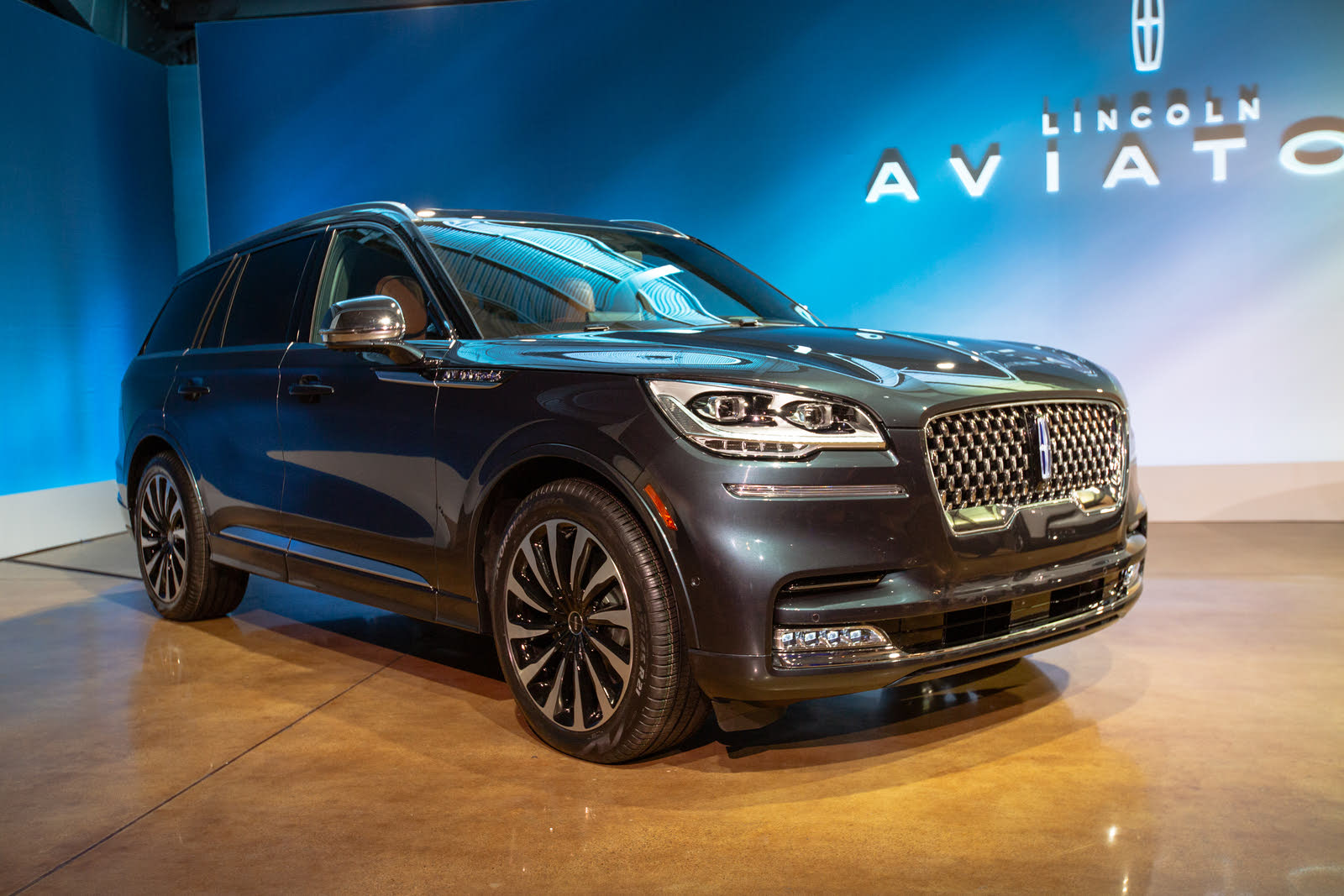
According to CarGurus experts, the overall rating for the 2020 Lincoln Aviator is 8.2 out of 10, while the 2021 Volkswagen ID.4 scores 7.3 out of 10. Based on these ratings, the Lincoln Aviator is the recommended choice, offering a more luxurious experience, powerful performance, and greater versatility with its three-row seating and hybrid option.
Choose the 2020 Lincoln Aviator if:
- You prioritize a luxurious interior with high-quality materials and unique features like orchestral warning jingles.
- You desire a powerful engine with a plug-in hybrid option for enhanced performance and efficiency.
- You need a spacious three-row SUV with ample cargo space and comfortable seating options.
Choose the 2021 Volkswagen ID.4 if:
- You are looking for an all-electric vehicle with a distinctive design and a focus on comfort.
- You value advanced safety features and high safety ratings from reputable organizations.
- You prefer a modern infotainment system with wireless smartphone integration and voice control.
CarGurus highlights

According to CarGurus experts, the overall rating for the 2020 Lincoln Aviator is 8.2 out of 10, while the 2021 Volkswagen ID.4 scores 7.3 out of 10. Based on these ratings, the Lincoln Aviator is the recommended choice, offering a more luxurious experience, powerful performance, and greater versatility with its three-row seating and hybrid option.
Choose the 2020 Lincoln Aviator if:
Shop Now- You prioritize a luxurious interior with high-quality materials and unique features like orchestral warning jingles.
- You desire a powerful engine with a plug-in hybrid option for enhanced performance and efficiency.
- You need a spacious three-row SUV with ample cargo space and comfortable seating options.
Choose the 2021 Volkswagen ID.4 if:
Shop Now- You are looking for an all-electric vehicle with a distinctive design and a focus on comfort.
- You value advanced safety features and high safety ratings from reputable organizations.
- You prefer a modern infotainment system with wireless smartphone integration and voice control.

By: CarGurus + AI
At CarGurus, our team of experienced automotive writers remain at the heart of our content operation, conducting hands-on car tests and writing insightful guides that are backed by years of industry experience. To complement this, we are harnessing AI to make our content offering more diverse and more helpful to shoppers than ever. To achieve this, our AI systems are based exclusively on CarGurus content, ratings and data, so that what we produce is both unique to CarGurus, and uniquely helpful to car shoppers.

